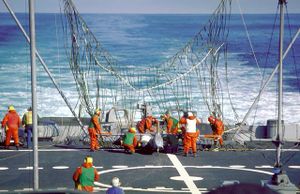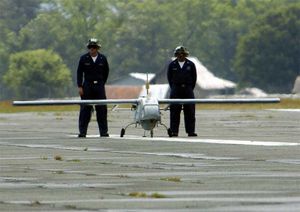PlaneSpottingWorld welcomes all new members! Please gives your ideas at the Terminal.
RQ-2 Pioneer

Developed jointly by AAI Corporation and Israel Aircraft Industries, the RQ-2 Pioneer unmanned aerial vehicle (UAV) has served with United States Navy, Marine, and Army units, deploying aboard ship and ashore since 1986. Initially deployed aboard battleships to provide gunnery spotting, its mission evolved into reconnaissance and surveillance, primarily for amphibious forces. Launched by rocket assist (shipboard), by catapult, or from a runway, it recovers into a net (shipboard) or with arresting gear after flying up to 5 hours with a 75-pound payload. It flies with a gimbaled EO/IR sensor, relaying analog video in real time via a C-band line-of-sight (LOS) data link. Since 1991, Pioneer has flown reconnaissance missions during the Persian Gulf, Bosnia, Kosovo and Iraq conflicts. In 2005, the Navy operated two Pioneer systems (one for training) and the Marines operated two, each with five or more aircraft.
Internationally, Pioneer drones are perhaps most remembered for their role in the 1991 Gulf War, when a Pioneer launched by the battleship Wisconsin observed Iraqi troops on Faylaka Island surrendering shortly after Missouri’s attack on their trenchlines. When Navy officials offered to transfer a Pioneer to the Smithsonian Institution, curators at the National Air and Space Museum specifically asked for the UAV that Iraqi troops surrendered to during the Gulf War[1].
The "R" is the Department of Defense designation for reconnaissance; "Q" means unmanned aircraft system. The "2" refers to it being the second of a series of purpose-built unmanned reconnaissance aircraft systems.
General Characteristics
- Primary Function: Artillery Targeting and Acquisition, Control of Close Air Support, Reconnaissance and Surveillance, Battle Damage Assessment, Search and Rescue, Psychological Operations
- Contractor: Pioneer UAVs, Incorporated ; Israel Aircraft Industries
- Power Plant: Sachs 2-stroke crankcase-scavanged 2-cylinder horizontally-opposed, simultaneously firing 26hp
- Length: 14 feet
- Height: 3.3 feet
- Weight: 205 kilograms (452 pounds)
- Wingspan: 16.9 feet
- Speed: 110 knots
- Range: five hours at 185 kilometers (100 nautical miles)
- Ceiling: 4600 meters (15,000 feet)
- Fuel Capacity: 44-47 liters
- Payload: Dual Sensor (12DS/POP-200)
- System Cost:
- Inventory:
Squadrons
TAW-6 DETUAV OLF Choctaw, FL
Navy
VC-6 'Firebees'
Marine Corps
VMU-1 'Watchdogs' 29 Palms, CA
VMU-2 'Night Owls' Cherry Point, NC
Related content
Designation sequence
Related lists
See also
Lists relating to aviation | |
|---|---|
| General | Timeline of aviation · Aircraft · Aircraft manufacturers · Aircraft engines · Aircraft engine manufacturers · Airports · Airlines |
| Military | Air forces · Aircraft weapons · Missiles · Unmanned aerial vehicles (UAVs) · Experimental aircraft |
| Notable incidents and accidents | Military aviation · Airliners · General aviation · Famous aviation-related deaths |
| Records | Flight airspeed record · Flight distance record · Flight altitude record · Flight endurance record · Most produced aircraft |
de:AAI RQ-2 ko:RQ-2 파이오니어 he:RQ-2 פיוניר nl:RQ-2 Pioneer no:RQ-2 Pioneer


